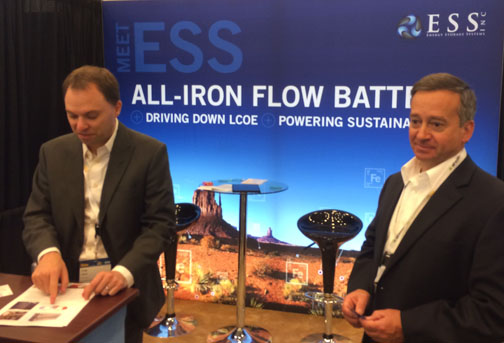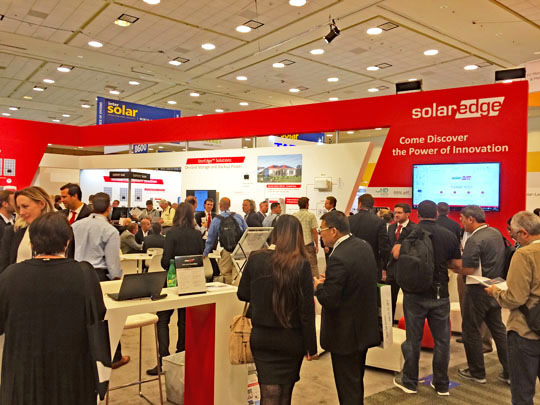InterSolar North America had some very interesting items on its exhibit floors — which filled all three floors of Moscone West Convention Center. InterSolar’s conference proceedings were going on down the street at the InterContinental Hotel.
Energy storage systems were the front-and-center topic on the exhibition floors. My first indicator of this new emphasis was a first glance at the event directory. Looking under the Exhibitor By Product Group index, I could not find inverters . There were four main topics for energy storage products, but no inverters? I eventually found inverters as a sub-section under Balance of System (BOS) — what solar people like to call everything except the solar panels. There were, however, quite a large number of companies (28) listed for inverters.
But this does show a shift of emphasis to storage systems. One of the reasons may be that inverter manufacturers are facing strong price pressures and accompanying low profit margins, though sales are said to be strong overall.
The energy storage area has three types — back-up batteries, residential storage, and utility-grade storage. It’s important to understand that, depending on the system, a residential solar energy battery may get cycled every day and batteries deteriorate based on charge-discharge cycles. The latest Li-ion cells are specified for 10,000 cycles. Lead-acid batteries are only good for a few hundred cycles, but are a lower cost alternative — good for an emergency standby application when a battery may be cycled only a couple of times a year. InterSolar had Li-ion, lead-acid, and NiCD/NiMh batteries, plus newer flow and saltwater batteries on exhibit.
Aquion Energy 's patented Aqueous Hybrid Ion (AHI) technology is a unique saltwater battery chemistry made from abundant, non-toxic materials. It contains no heavy metals or toxic chemicals and is non-flammable. The batteries are completely sealed and do not require maintenance. The Aspen 24S-83 2.1-kWh battery 24-V stack costs about $1,300. It will handle 750-W peak and has a 36.8 x 13.0 x 12.2-in. size, weighing in at 260 lbs. Cycle life is 3,000 (to 70% retained capacity).
ESS was showing off their All-Iron Flow Battery (well, pictures of it) that provides a whopping 800 kWh. This is another eco-friendly unit using only iron, salt, and water for its electrolyte. The battery comes in a rugged ISO container that can be transported pre-assembled anywhere in the world. As you would expect from the amount of energy they provide, it is not small. At 40 x 8 x 8.5 ft. and 16,000 kg, these are not watch batteries. FB batteries can handle over 20,000 cycles at over 80% depth of discharge during their 25-year life with minimal maintenance. The units have a 480-VAC, three-phase interface and operate over −5°C to 50°C. Ac/ac round-trip efficiency is better than 70%.

Fig. 1: Craig Evans, president, and Bill Sproull, VP of business development, at ESS.
One inverter system company making their presence known was SolarEdge . Rather than use a micro-inverter, SolarEdge uses what they call a power optimizer , which is a dc/dc converter connected by installers to each PV module or embedded by solar module manufacturers. The optimizers track the maximum power point (MPPT) of each module. They also monitor the performance of each module and communicate data to a monitoring portal.

Fig: 2: The very active SolarEdge booth at InterSolar North America.
The optimizer modules are connected to a main inverter, which the company says is less expensive and more reliable than using micro-inverters. Each power optimizer has a SafeDC feature which, for safety, automatically shuts down the modules' dc output whenever the inverter or grid power is shut off. SolarEdge states that efficiency is 99.5% peak and up to 98.8% weighted. The optimizers come in four different versions for various solar panels. The main inverter is offered in ratings 3 to 11.4 kW single-phase and up to 33 kW in a 480-V, three-phase version.
SolarEdge won an InterSolar award for their HD-Wave inverter technology. HD-Wave is said to employ distributed switching and advanced digital processing to synthesize a clean, high-definition sine wave. The inverters have less than half of the heat dissipation, 16 times fewer magnetics, and 2.5 times fewer cooling components than current SolarEdge inverters.
APsystems is another manufacturer with a micro-inverter solution. They offer the YC500 two-panel inverter and the YC1000 three-phase, four-panel model. These have separate inverters performing MPPT for each panel in a single package for lower cost and easier installation. The YC500 is specified as having peak efficiency of 95.5% for the 8.6 x 5.4 x 1.37-in. unit. It has 208- or 240-VAC outputs and is designed to operate from −40°F to 149°F.

Fig. 3: The YC series from APsystems.
Another award winner was LG Electronics Deutschland for their Solar Module LG NeON 2 BiFacial solar panel, which yields a 10% efficiency over last year's version.
The InterSolar folks estimate that global PV installations this year will be 280,000 MW, and by 2019, it will grow to 480,000 MW. There are still a number of different approaches for inverter and storage systems that will tame all those megawatts and put them to good use.
Advertisement





